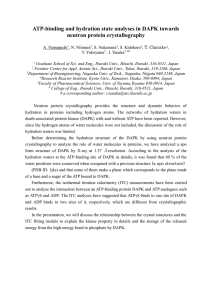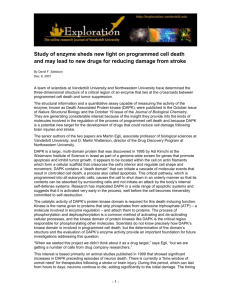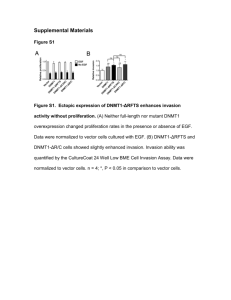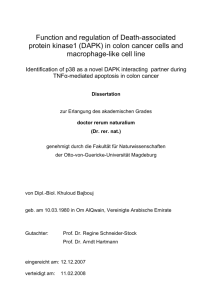Supplementary Figure Legends (doc 34K)
advertisement
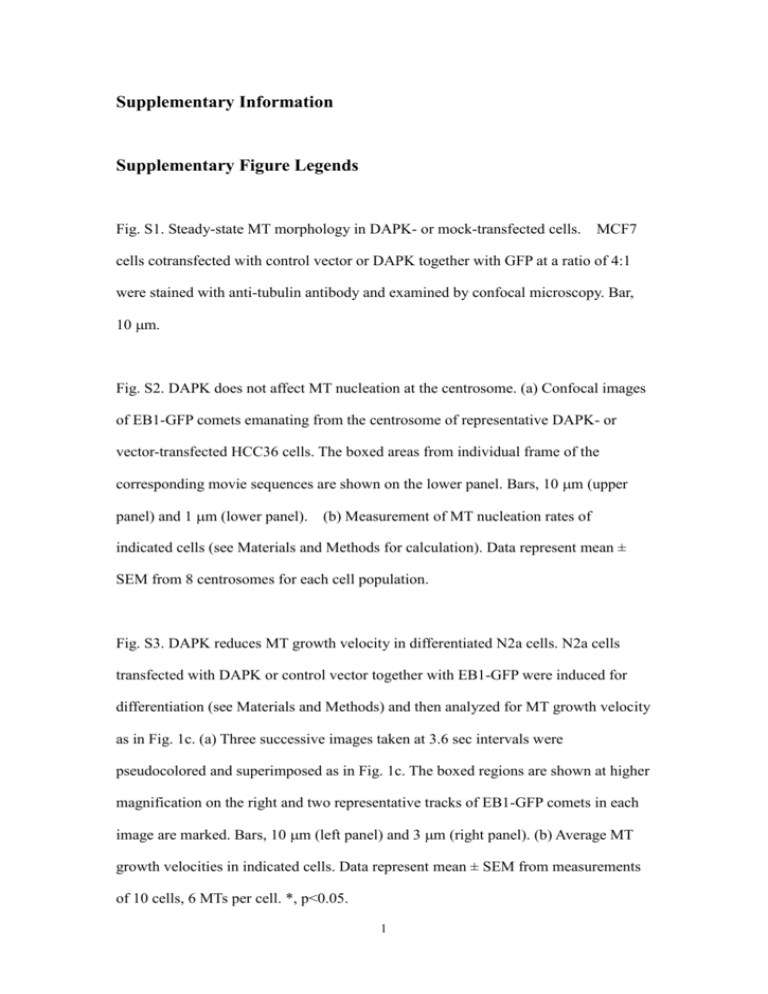
Supplementary Information Supplementary Figure Legends Fig. S1. Steady-state MT morphology in DAPK- or mock-transfected cells. MCF7 cells cotransfected with control vector or DAPK together with GFP at a ratio of 4:1 were stained with anti-tubulin antibody and examined by confocal microscopy. Bar, 10 m. Fig. S2. DAPK does not affect MT nucleation at the centrosome. (a) Confocal images of EB1-GFP comets emanating from the centrosome of representative DAPK- or vector-transfected HCC36 cells. The boxed areas from individual frame of the corresponding movie sequences are shown on the lower panel. Bars, 10 m (upper panel) and 1 m (lower panel). (b) Measurement of MT nucleation rates of indicated cells (see Materials and Methods for calculation). Data represent mean ± SEM from 8 centrosomes for each cell population. Fig. S3. DAPK reduces MT growth velocity in differentiated N2a cells. N2a cells transfected with DAPK or control vector together with EB1-GFP were induced for differentiation (see Materials and Methods) and then analyzed for MT growth velocity as in Fig. 1c. (a) Three successive images taken at 3.6 sec intervals were pseudocolored and superimposed as in Fig. 1c. The boxed regions are shown at higher magnification on the right and two representative tracks of EB1-GFP comets in each image are marked. Bars, 10 m (left panel) and 3 m (right panel). (b) Average MT growth velocities in indicated cells. Data represent mean ± SEM from measurements of 10 cells, 6 MTs per cell. *, p<0.05. 1 Fig. S4. DAPK does not phosphorylate tau. Flag-DAPK or Flag-DAPK K42A immunoprecipitated from transfected cells were subjected to in vitro kinase reaction using full-length tau, tau-C, or myosin light chain II (MLC) as a substrate. Substrate phosphorylation was detected by autoradiography (upper panel). The input amounts of substrates and DAPK are shown on the lower panels. Fig. S5. DAPK catalytic activity is not affected by MARK1 or MARK2. 293T cells transfected with indicated constructs were lysed for immunoprecipitation with anti-Flag antibody. The immunoprecipitates were used for kinase assay with GST-MLC as a substrate (upper panel). The immunoprecipitates and cell lysates were used for immunoblot with antibodies as indicated (lower panels). Fig. S6. Endogenous DAPK promotes MARK2-induced tau S262 phosphorylation in neurons and specificity analysis of DAPK and MARK2 antibodies. (a) Rat hippocampal neurons were transfected with GFP, MARK2, and DAPK siRNA (or control siRNA) at DIV3. Cells were fixed and stained with pS262 tau antibody at DIV5 and analyzed by confocal microscopy. (b) The specificities of DAPK and MARK2 antibodies. Primary rat hippocampal neurons were co-transfected with control siRNA, DAPK siRNA or MARK2 siRNA, together with GFP constructs at a ratio of 4:1. The neurons were fixed, stained with anti-DAPK or anti-MARK2 antibody, and examined by confocal microscopy. The pS262, DAPK and MARK2 immunofluorescent signals were quantified using a method described in the Materials and Methods and plotted. Data represent mean ± SEM from there independent experiments and at least 20 GFP-positive neurons were analyzed for each transfection. *, p<0.05. Bar, 20 m. 2 Fig. S7. DAPK DD interacts with the spacer region of MARK1. 293T cells transfected with GFP-DD and/or Flag-MARK1-S (spacer region of MARK1) were lysed for immunoprecipitation with anti-Flag antibody. The immunoprecipitates and cell lysates were analyzed by immunoblot with antibodies as indicated. Fig. 8. Disrupting or mimicking MARK2 T595 phosphorylation does not affect its interaction with DAPK. 293T cells co-transfected with DAPK and MARK2 or its mutant were analyzed by immunoprecipitation and/or immunoblot with antibodies as indicated. Fig. S9. DAPK does not affect MARK1/2 phosphorylation at their activation loops. 293T cells transfected with indicated constructs were analyzed by immunoblot with anti-Flag, anti-phospho-MARK and anti-tubulin antibodies. Fig. S10. Phosphorylation of MARK2 activation loop does not affect its binding to DAPK. 293T cells transfected with indicated constructs were analyzed by immunoprecipitation and immunoblot with antibodies as indicated. Fig. 11. DAPK expression levels in indicated transgenic flies were analyzed by immunoblot. Supplementary Movie Titles 3 Movie 1. Movement of EB1-GFP along growing MTs in cell transfected with control vector or DAPK (same cells as in Fig. 1c). Images were taken at 0.3-sec intervals. Movie 2. Emergence of EB-GFP dashes from the centrosome in cell transfected with control vector (same cell as in Supplementary Fig. S2a). Images were taken at 0.3-sec intervals. Movie 3. Emergence of EB-GFP dashes from the centrosome in cell transfected with DAPK (same cell as in Supplementary Fig. S2a). Images were taken at 0.3-sec intervals. 4
